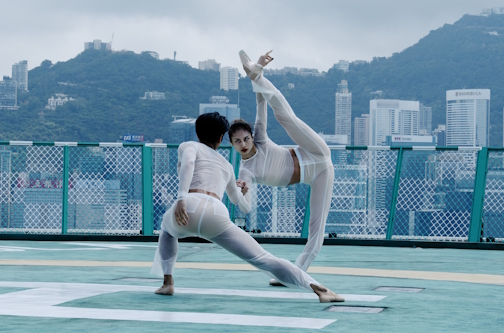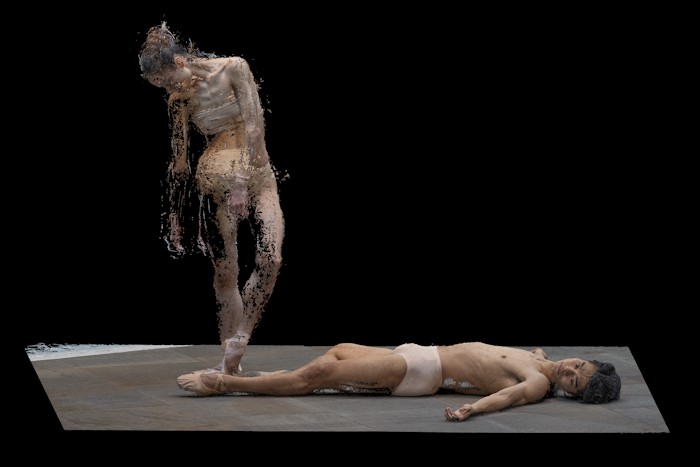Stone Nest, London
In the heart of London’s theatre district, not far from Leicester Square, stands an old Welsh chapel built in 1888. Its stone walls have heard hymns, silence, and later the noise of bars and nightclubs. Now, inside those same walls, high-tech projectors pulse like a digital nervous system. This is choreographer Wayne McGregor’s rabbit hole, his twenty-first-century Alice in Wonderland.
Step inside and the illusion begins. The air hums with hidden machines, light seeps through the cracks of history. Soon the dream turns on, woven not by you but for you, generated by data.
The stone remembers faith, the algorithm invents vision. Between them, a new kind of body flickers into existence.
Watching On the Other Earth feels like being digitally possessed. For nearly an hour, the audience must stand, walk and turn endlessly. The body tires before the mind catches up. Screens attack from all sides, flooding sight with too much to hold.

(pictured: Company Wayne McGregor dancer Naia Bautista)
Photo Ravi Deepres/Luke Unsworth
I felt physically exhausted, not just from standing, but from being seen, scanned, surrounded by data. It was the fatigue of being processed. The pressure of everything happening to you from every direction, the ache in the back, the blur in the eyes, the mind’s inability to stay focused, all of it becomes a kind of bodily testimony.
Dancers appear and vanish like digital ghosts, near enough for breath yet carrying no human warmth. Sometimes they grow enormous, their scale an order rather than a presence. Choreography here feels secondary; what truly moves is the act of watching.
I felt my nervous system had been put on display along with the dancers. The system does not ask you to feel; it commands you to look.
Two male dancers appear, their duet fragmented across multiple screens. One image mirrors another while time drifts out of sync, each reflection trapped between recognition and repetition.
The fourth wall no longer breaks; it simply does not exist. Space folds, time duplicates, and the audience hovers in a corridor of versions, witnesses and residues at once.

(pictured: Hong Kong Ballet dancers Gouta Seki and Wang Qingxin)
Photo Ravi Deepres
When the skyline of Hong Kong appears, the view of Victoria Harbour, I nearly cry. How long has it been since I last saw that vista? The digital harbour glows before me, and I stop watching the dancers altogether. For several minutes I can only stare, holding back tears.
The figures on screen dissolve into particles, drifting closer. I wonder if they will pass through my body, leave a trace of cold behind. A faint warmth lingers in the air, like the breath of someone who has just disappeared.
Then the world flips. Bodies dance upside down across the ceiling, moving with the scratchy silence of small animals nesting in the roof. They twist and crawl just above the audience, close enough to unsettle. The scene feels lifted from a vampire film, a slow horror where gravity and grace collapse together.
Later, the ghosts return clothed in white gauze, advancing from all directions. Their hands trace invisible lines above the audience’s heads. I could swear they were touching me, stroking hair, shoulders, but there was no sensation. Only the projector’s heat, warm as a human body yet belonging to no one.

(pictured: Company Wayne McGregor dancer Jasiah Marshall)
Photo Ravi Deepres/Luke Unsworth
Towards the end, a female dancer multiplies into flaming echoes. Red and orange flood the circular room until all form burns away. Her movements ripple like waves of heat. When she bends down, darkness briefly cools the air. Then she turns and walks off, leaving a tunnel of light behind her. Instinct tells me to follow, that if I do, I might return to reality.
It is gone. After vision and error comes silence.
Fifty-seven minutes of pure data, of beauty too crowded to be named. I am not quite sure what I have experienced, a performance, an experiment, or a ritual for the ghosts of the digital age.
If Infinite Bodies, the parallel exhibition at Somerset House is about technology learning to see, then On the Other Earth is where the system begins to dream.
Dreams once belonged to the soul; in code they find a new host. And in that transfer, something fragile remains, the heat of absence, the body’s last illusion of being real. This is indeed McGregor’s rabbit hole; Alice’s descent rewritten by data.
We walked out of the cylinder, looked at each other and said, “It’s just a dream.” It was the same dream, built by the same code, yet each of us saw a different truth. Perhaps that difference is what keeps us human.
On the Other Earth at Stone Nest, and Infinite Bodies at Somerset House, London, both run to February 22, 2026.

